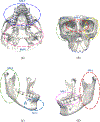Localization of Craniomaxillofacial Landmarks on CBCT Images Using 3D Mask R-CNN and Local Dependency Learning
- PMID: 35544487
- PMCID: PMC9673501
- DOI: 10.1109/TMI.2022.3174513
Localization of Craniomaxillofacial Landmarks on CBCT Images Using 3D Mask R-CNN and Local Dependency Learning
Abstract
Cephalometric analysis relies on accurate detection of craniomaxillofacial (CMF) landmarks from cone-beam computed tomography (CBCT) images. However, due to the complexity of CMF bony structures, it is difficult to localize landmarks efficiently and accurately. In this paper, we propose a deep learning framework to tackle this challenge by jointly digitalizing 105 CMF landmarks on CBCT images. By explicitly learning the local geometrical relationships between the landmarks, our approach extends Mask R-CNN for end-to-end prediction of landmark locations. Specifically, we first apply a detection network on a down-sampled 3D image to leverage global contextual information to predict the approximate locations of the landmarks. We subsequently leverage local information provided by higher-resolution image patches to refine the landmark locations. On patients with varying non-syndromic jaw deformities, our method achieves an average detection accuracy of 1.38± 0.95mm, outperforming a related state-of-the-art method.
Figures







Similar articles
-
Fast and Accurate Craniomaxillofacial Landmark Detection via 3D Faster R-CNN.IEEE Trans Med Imaging. 2021 Dec;40(12):3867-3878. doi: 10.1109/TMI.2021.3099509. Epub 2021 Nov 30. IEEE Trans Med Imaging. 2021. PMID: 34310293 Free PMC article.
-
CMF-Net: craniomaxillofacial landmark localization on CBCT images using geometric constraint and transformer.Phys Med Biol. 2023 Apr 26;68(9). doi: 10.1088/1361-6560/acb483. Phys Med Biol. 2023. PMID: 36652722
-
Context-guided fully convolutional networks for joint craniomaxillofacial bone segmentation and landmark digitization.Med Image Anal. 2020 Feb;60:101621. doi: 10.1016/j.media.2019.101621. Epub 2019 Nov 23. Med Image Anal. 2020. PMID: 31816592 Free PMC article.
-
Reliability of different three-dimensional cephalometric landmarks in cone-beam computed tomography : A systematic review.Angle Orthod. 2019 Mar;89(2):317-332. doi: 10.2319/042018-302.1. Epub 2018 Nov 13. Angle Orthod. 2019. PMID: 30423256 Free PMC article.
-
Can artificial intelligence-driven cephalometric analysis replace manual tracing? A systematic review and meta-analysis.Eur J Orthod. 2024 Aug 1;46(4):cjae029. doi: 10.1093/ejo/cjae029. Eur J Orthod. 2024. PMID: 38895901 Free PMC article.
Cited by
-
Explainable deep learning for age and gender estimation in dental CBCT scans using attention mechanisms and multi task learning.Sci Rep. 2025 May 24;15(1):18070. doi: 10.1038/s41598-025-03305-z. Sci Rep. 2025. PMID: 40413203 Free PMC article.
-
Application of deep learning in wound size measurement using fingernail as the reference.BMC Med Inform Decis Mak. 2024 Dec 18;24(1):390. doi: 10.1186/s12911-024-02778-8. BMC Med Inform Decis Mak. 2024. PMID: 39696347 Free PMC article.
-
Automatic craniomaxillofacial landmarks detection in CT images of individuals with dentomaxillofacial deformities by a two-stage deep learning model.BMC Oral Health. 2023 Nov 17;23(1):876. doi: 10.1186/s12903-023-03446-5. BMC Oral Health. 2023. PMID: 37978486 Free PMC article.
-
The Application of Deep Learning on CBCT in Dentistry.Diagnostics (Basel). 2023 Jun 14;13(12):2056. doi: 10.3390/diagnostics13122056. Diagnostics (Basel). 2023. PMID: 37370951 Free PMC article. Review.
-
A Proof of Concept: Optimized Jawbone-Reduction Model for Mandibular Fracture Surgery.J Imaging Inform Med. 2024 Jun;37(3):1151-1159. doi: 10.1007/s10278-024-01014-z. Epub 2024 Feb 8. J Imaging Inform Med. 2024. PMID: 38332406 Free PMC article.
References
-
- Dai J, Li Y, He K. and Sun J, “R-FCN: Object detection via region-based fully convolutional networks,” Proc. Adv. Neural Inf. Process. Syst, pp. 379–387, 2016.
-
- Tompson J, Goroshin R, Jain A, LeCun Y. and Bregler C, “Efficient object localization using convolutional networks,” Proc. IEEE Conf. Comput. Vis. Pattern Recognit, pp. 648–656, 2015.
-
- Liang Z, Ding S, and Lin L, “Unconstrained faciallandmark localization with backbone-branches fully-convolutional networks,” [Online]. : https://arxiv.org/abs/1507.03409.
-
- Zhan Y, Dewan M, Harder M, Krishnan A, Zhou XS, “Robust automatic knee MR slice positioning through redundant and hierarchical anatomy detection,” IEEE Trans. Med. Imag, vol. 30, no. 12, pp. 2087–2100, Dec. 2011. - PubMed

